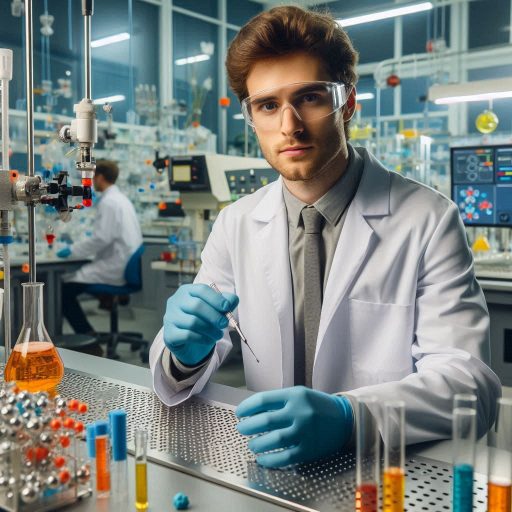Introduction
Conferences play a vital role for materials science professionals.
They provide a platform for learning and collaboration.
These events help professionals stay updated on the latest research and trends.
Attending conferences enables scientists to share their findings and innovations.
Networking is a key benefit of participating in conferences.
Professionals meet industry leaders, researchers, and potential collaborators.
These interactions can lead to valuable partnerships and career opportunities.
Engaging with peers fosters a sense of community within the field.
Knowledge sharing is another crucial aspect of conferences.
Presentations, workshops, and panel discussions allow experts to showcase their work.
Attendees gain insights into new techniques, materials, and technologies.
This exchange of ideas inspires innovation and drives progress in materials science.
Moreover, conferences often feature exhibitions.
These exhibitions allow companies to showcase their latest products and solutions.
Participants can explore cutting-edge technologies that can enhance their research or practices.
In general, conferences are essential for materials science professionals.
They promote networking, knowledge sharing, and collaboration.
By attending these events, professionals enhance their expertise and contribute to advancements in the field.
Engaging with the community is vital for personal and professional growth.
Therefore, professionals should actively seek opportunities to participate in conferences.
Materials Research Society (MRS) Spring Meeting
Overview of the Conference’s History and Significance in the Materials Science Community
The Materials Research Society (MRS) Spring Meeting is a cornerstone event in the materials science community.
Established in 1973, the MRS has become a premier forum for researchers and professionals.
Each year, it attracts thousands of attendees from around the globe.
The conference provides a vital platform for presenting cutting-edge advancements in materials science.
Its long history highlights its significance as a leader in fostering collaboration and innovation in the field.
Key Topics Usually Covered at the Conference
The MRS Spring Meeting covers a diverse range of topics essential to the materials science field.
Key areas of focus include nanomaterials, biomaterials, and energy materials.
Participants engage in discussions about emerging technologies and innovative research findings.
Sessions often explore characterization techniques and processing methods in depth.
The event also highlights the integration of materials science with related disciplines, such as physics and engineering.
This broad scope ensures that attendees stay informed about the latest developments in their areas of interest.
Notable Speakers and Presenters Who Have Participated in the Past
Notable speakers have graced the MRS Spring Meeting, enriching the conference experience.
Renowned scientists and industry leaders share their insights and expertise during keynote presentations.
Their contributions inspire attendees and foster new ideas for future research.
For instance, past speakers include Nobel laureates and influential researchers in materials science.
Their presence elevates the conference’s status and significance within the scientific community.
Additionally, the conference features various symposia and workshops, allowing for focused discussions on specialized topics.
The MRS Spring Meeting emphasizes student participation as well.
Many students present their research findings, gaining invaluable experience and exposure.
The conference offers awards for outstanding presentations, motivating students to excel in their work.
This focus on education strengthens the future of materials science and encourages the next generation of researchers.
Networking plays a crucial role at the MRS Spring Meeting as well.
Attendees connect with peers, industry professionals, and potential collaborators.
Informal gatherings and organized events facilitate these vital interactions.
Participants exchange ideas and explore partnership opportunities, fostering innovation within the field.
Overall, the MRS Spring Meeting is a vital conference for materials science professionals.
Its rich history, diverse topics, and esteemed speakers make it an essential event.
The gathering promotes collaboration and knowledge sharing, driving the field forward.
With its esteemed speakers and robust program, the conference attracts a global audience, solidifying its status as a must-attend event in the materials science calendar.
International Conference on Materials for Advanced Technologies (ICMAT)
The International Conference on Materials for Advanced Technologies (ICMAT) is a prestigious conference that focuses on cutting-edge materials research.
This conference serves as a platform for scientists, researchers, and professionals in the materials science field to present their latest findings, innovations, and discoveries.
Description of the conference’s focus on cutting-edge materials research
ICMAT showcases the latest advancements and breakthroughs in materials science, including nanotechnology, biomaterials, polymers, composites, and more.
Researchers present their work through keynote lectures, oral presentations, and poster sessions, providing attendees with insights into the future of materials development.
The global reach of the conference and attendees from various countries
ICMAT attracts participants from around the world, making it a truly global conference.
Scientists, researchers, and industry professionals from different countries come together to exchange ideas, collaborate on projects, and build partnerships.
This international collaboration enhances the diversity and richness of discussions at the conference.
Attendees at ICMAT represent a wide range of disciplines within materials science, including physics, chemistry, engineering, and materials design.
This diversity of expertise leads to stimulating discussions and new perspectives on material properties, processing techniques, and applications.
Networking opportunities available at ICMAT
ICMAT provides ample networking opportunities for participants to interact with leaders in the field, establish collaborations, and explore potential research partnerships.
The conference features social events, networking sessions, and exhibition spaces where attendees can engage with industry representatives and academic experts.
Networking at ICMAT allows professionals to exchange knowledge, share best practices, and stay abreast of the latest trends in materials science.
Building a strong network of contacts at the conference can lead to new research opportunities, funding prospects, and career advancements in the field.
In review, the International Conference on Materials for Advanced Technologies (ICMAT) provides a unique platform for materials science professionals.
Attendees engage in cutting-edge research and collaborate with experts from around the world.
They also expand their professional networks at this event.
Attendees can expect to gain valuable insights, forge new partnerships, and contribute to the advancement of materials science through their participation in this premier conference.
Read: US Chemistry Conferences and Symposiums to Attend in 2024
Materials Science and Technology (MS&T) Conference
The Conference’s Role in Bringing Together Materials Science Professionals
The Materials Science and Technology (MS&T) Conference serves as a vital hub for materials science professionals.
Each year, it attracts experts from academia, industry, and government sectors.
This convergence fosters collaboration and innovation among diverse disciplines within materials science.
The conference creates a platform for sharing knowledge and advancing research, enabling attendees to discuss current challenges and solutions in the field.
Diverse Range of Topics Covered
MS&T covers a wide range of topics in the materials field.
Participants engage in discussions surrounding metals, polymers, ceramics, and more.
The conference highlights cutting-edge research and developments that shape the future of materials.
Presentations and sessions address topics such as materials processing, characterization, and applications in various industries.
This breadth of subjects ensures that attendees find relevant sessions tailored to their interests and professional needs.
The Technical Symposia and Workshops Offered at MS&T
Technical symposia form a core component of the MS&T experience.
These symposia focus on specific areas of materials science, allowing for in-depth exploration of critical subjects.
Experts present their latest findings, enabling attendees to gain insights into current trends and future directions.
This dynamic exchange of knowledge enhances understanding and stimulates new ideas within the community.
Workshops at MS&T offer hands-on experiences and practical skills.
They provide attendees with opportunities to learn from industry leaders and academics.
These interactive sessions cover various techniques, tools, and methodologies relevant to materials science.
Participants can apply what they learn directly to their work, enhancing their professional development.
Networking opportunities abound at MS&T.
Attendees can connect with like-minded professionals, fostering valuable relationships.
These connections often lead to collaborations and career advancements.
Engaging with peers and leaders in the field enriches the conference experience.
The conference also includes an exhibition area.
Here, companies showcase their latest products and technologies.
This interaction between exhibitors and attendees facilitates conversations about practical applications.
Participants can explore innovations that can enhance their work and research.
Furthermore, the MS&T Conference emphasizes student involvement.
It provides a platform for emerging professionals to present their research.
This exposure helps students build their networks and gain recognition in the field.
Engaging with seasoned professionals offers students mentorship opportunities, fostering their growth.
In essence, the MS&T Conference plays a pivotal role in advancing the field of materials science.
By bringing together professionals from diverse backgrounds, it encourages collaboration and innovation.
Read: Key Roles and Responsibilities of a Chemist in the US
American Ceramic Society (ACerS) Meetings
The Specialized Nature of ACerS Meetings
The American Ceramic Society (ACerS) hosts specialized meetings that cater to professionals in the ceramics field.
These gatherings focus on the unique challenges and innovations within the ceramics industry.
By attending ACerS meetings, professionals can immerse themselves in a community dedicated to advancing ceramics technology.
The Wide Range of Topics Covered Within the Ceramics Field
ACerS meetings cover a wide range of topics.
Participants explore the latest research in materials, processing techniques, and applications of ceramics.
Sessions may delve into advanced ceramics, glass technology, and ceramic coatings.
Attendees also learn about innovative manufacturing methods and sustainable practices in ceramics.
The diverse agenda ensures that professionals from various sectors gain valuable insights.
The Collaboration Opportunities and Industry Connections Available at ACerS Meetings
Networking plays a significant role at ACerS meetings.
These events provide excellent opportunities for industry connections.
Attendees can meet leading experts and researchers in ceramics.
They engage with peers facing similar challenges.
Building relationships with other professionals fosters collaboration and knowledge exchange.
This networking aspect enhances the overall experience of attending ACerS meetings.
The collaboration opportunities at ACerS meetings are noteworthy.
Professionals participate in workshops and panel discussions.
These interactive sessions encourage open dialogue about emerging trends and issues in ceramics.
Participants share experiences and learn from each other.
This collaborative environment stimulates innovative ideas and problem-solving.
ACerS meetings also feature an exhibit hall showcasing cutting-edge technologies and products.
Vendors display their latest advancements in ceramics and related fields.
This space allows attendees to interact with industry leaders and explore new tools.
Participants can ask questions, obtain demonstrations, and gain hands-on experience.
This exposure to new technologies enhances participants‘ understanding of the ceramics landscape.
Additionally, ACerS meetings often include awards and recognitions for outstanding contributions to the field.
This acknowledgment highlights the importance of excellence in ceramics research and innovation.
It inspires attendees to strive for their best work and contribute meaningfully to the community.
In general, the American Ceramic Society meetings serve as a vital resource for ceramics professionals.
They offer specialized content, diverse topics, and robust networking opportunities.
The chance to collaborate with peers and industry leaders is invaluable.
Participants leave these meetings with new knowledge, connections, and inspiration.
Engaging with the vibrant ceramics community strengthens the industry’s future and fosters ongoing innovation.
By attending ACerS meetings, professionals position themselves at the forefront of ceramics science and technology.
Read: Earning Potential: Chemist Salaries Across US States

Discover More: Hydrologist Specializations: Surface vs. Groundwater
You Might Also Like: Biomedical Engineering: Advances in Medical Imaging
European Materials Research Society (E-MRS) Spring Meeting
Overview of the Conference’s Emphasis on Interdisciplinary Materials Research
The European Materials Research Society (E-MRS) Spring Meeting stands as a premier event in the materials science field.
This conference emphasizes interdisciplinary research, attracting scientists from various disciplines.
Researchers share innovative ideas and findings that push the boundaries of materials science.
E-MRS encourages collaboration among academia, industry, and research institutions.
This synergy fosters advancements in fields like nanotechnology, biomaterials, and sustainable materials.
Transform Your Career Today
Unlock a personalized career strategy that drives real results. Get tailored advice and a roadmap designed just for you.
Start NowThe Vibrant Scientific Program and Exhibition at E-MRS Meetings
The scientific program at the E-MRS Spring Meeting is vibrant and diverse.
It features keynote speakers, oral presentations, and poster sessions.
Renowned experts present cutting-edge research, showcasing the latest trends in materials science.
Topics cover everything from advanced materials characterization to the development of smart materials.
The conference also includes special symposia that delve into specific areas of interest.
Attendees can engage in discussions about current challenges and future directions in materials research.
An exhibition accompanies the scientific program, providing companies a platform to showcase their latest technologies.
Industry leaders present innovations that enhance materials development and manufacturing processes.
This interaction between researchers and industry professionals stimulates collaborative opportunities.
Attendees can explore new tools and equipment that may benefit their research endeavors.
The exhibition hall buzzes with excitement, reflecting the dynamic nature of the materials science community.
The Networking Events and Social Activities Offered to Attendees
Networking is a crucial component of the E-MRS Spring Meeting.
The conference offers various social activities that promote connections among attendees.
From coffee breaks to evening receptions, participants can mingle and exchange ideas.
These informal settings encourage the sharing of experiences and foster professional relationships.
Many attendees find collaborators for future projects during these events.
Additionally, E-MRS organizes dedicated networking sessions, allowing participants to engage more deeply.
These sessions focus on specific topics, enabling attendees to connect with like-minded professionals.
Researchers can discuss ongoing projects, seek advice, and explore potential partnerships.
Networking at E-MRS opens doors to new opportunities and enhances professional growth.
Social activities also add a fun element to the conference experience.
Organizers often plan cultural outings and guided tours of the host city.
Attendees can immerse themselves in the local culture while building relationships with peers.
These experiences create lasting memories and strengthen the bonds within the materials science community.
In a nutshell, the E-MRS Spring Meeting emphasizes interdisciplinary research, a vibrant scientific program, and invaluable networking opportunities.
Participants gain insights into cutting-edge developments in materials science.
They leave inspired and equipped to advance their research and careers.
Engaging with peers and industry leaders enhances the overall experience, making this conference a must-attend event.
Read: Top Chemistry Departments and Schools in the US
Discover More: The Role of Soil Scientists in Urban Gardens
Materials Science and Engineering for Renewable Energy (MSERA) Conference
The Conference’s Focus on Materials Research for Sustainable Energy Applications
The Materials Science and Engineering for Renewable Energy (MSERA) Conference is a key event for materials science professionals.
This conference focuses on research that advances sustainable energy applications.
It showcases innovative materials that drive renewable energy technologies.
By attending MSERA, participants explore the latest advancements in materials science aimed at reducing environmental impact.
The Innovative Research Presented at MSERA and Its Impact on the Field
Researchers present cutting-edge studies on materials for solar cells, wind turbines, and energy storage.
These presentations highlight significant breakthroughs that improve efficiency and lower costs.
For example, recent research has focused on perovskite solar cells.
These materials promise higher efficiency rates compared to traditional silicon-based solar panels.
Their potential could revolutionize the solar energy market.
Additionally, the conference features discussions on materials for battery technology.
Researchers share findings on lithium-sulfur and solid-state batteries.
These advancements may lead to longer-lasting and safer energy storage solutions.
The knowledge shared at MSERA can inspire new approaches to existing challenges in renewable energy.
The Opportunities for Collaboration and Funding at the Conference
Networking opportunities abound at the MSERA Conference.
Attendees connect with industry leaders, researchers, and policymakers.
These interactions foster collaboration among academia, government, and industry.
By forming partnerships, participants can enhance their research initiatives and expand their reach.
The conference also encourages collaborative projects.
Many sessions highlight successful joint research efforts.
These collaborations often lead to significant advancements in materials science.
They emphasize the importance of multidisciplinary approaches to solve complex energy problems.
Funding opportunities are another key feature of the MSERA Conference.
Several organizations attend to scout promising research projects.
Participants have the chance to pitch their ideas to potential investors.
This aspect of the conference can help secure funding for innovative research.
The MSERA Conference not only highlights current research but also shapes future directions in the field.
By focusing on sustainable materials, the conference aligns with global energy goals.
Participants contribute to discussions that can lead to practical solutions for pressing environmental issues.
In fact, the MSERA Conference serves as a vital platform for materials science professionals.
It emphasizes the importance of research focused on renewable energy applications.
The innovative findings presented at the conference drive the field forward.
Additionally, opportunities for collaboration and funding enhance the potential impact of research initiatives.
Attending the MSERA Conference is essential for anyone passionate about materials science and renewable energy.
It inspires new ideas and encourages meaningful connections.
By engaging with experts in the field, attendees can influence the future of sustainable energy technologies.
Conclusion
In this blog, we explored various popular conferences for materials science professionals.
These events serve as vital platforms for networking and knowledge exchange.
Attendees gain insights from industry leaders and innovative researchers.
Engaging with peers fosters collaboration and inspires new ideas.
Conferences also provide access to cutting-edge research and advancements in materials science.
Participants can attend workshops that enhance their practical skills and knowledge.
By presenting their work, professionals showcase their expertise and contribute to the field‘s growth.
Networking opportunities at these events are invaluable.
Meeting industry experts can lead to potential collaborations and job opportunities.
Building relationships with fellow attendees enriches professional connections and broadens career prospects.
Attending conferences can significantly advance your career.
Exposure to diverse perspectives enhances your understanding of materials science trends.
You can stay updated on emerging technologies and methodologies by participating in discussions.
In summary, attending popular conferences is essential for materials science professionals.
These gatherings promote learning, foster relationships, and stimulate career growth.
By engaging with the materials science community, you can gain insights that shape your future.
Embrace the opportunity to connect, learn, and advance in this dynamic field.
[E-Books for Sale]
The Big Book of 500 High-Paying Jobs in America: Unlock Your Earning Potential
$19.99 • 500 High-Paying Jobs • 330 pages
Explore 500 high-paying jobs in America and learn how to boost your career, earn more, and achieve success!
See All 500 High-Paying Jobs of this E-Book
1001 Professions Without a Degree: High-Paying American Jobs You Can Start Now
$19.99 • 1001 Professions Without a Degree • 174 pages
Discover 1001 high-paying jobs without a degree! Unlock career tips, skills, and success strategies for just $19.99!




